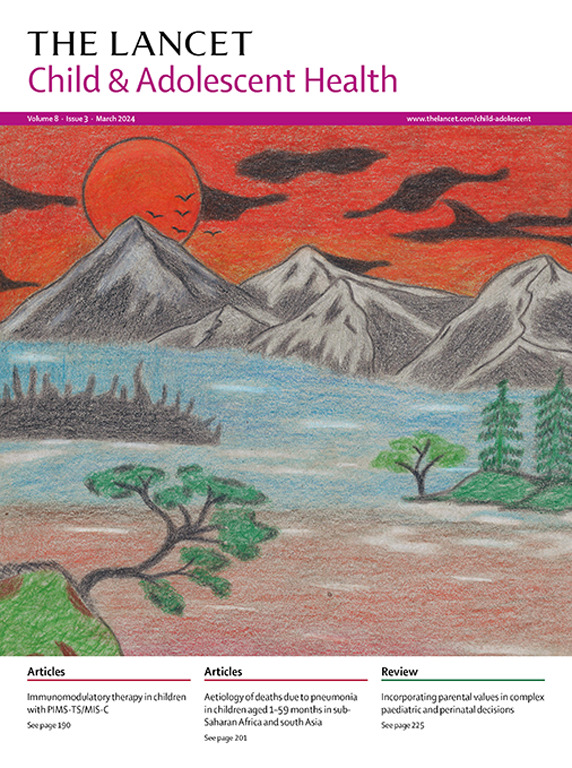Alternative consent processes in a neonatal resuscitation trial (SAIL): secondary analysis of an open-label, international, multicentre, randomised trial
IF 15.5
1区 医学
Q1 PEDIATRICS
引用次数: 0
Abstract
Background
Delivery room trials face ethical and logistical enrolment challenges, including requirements for prospective, antenatal, parental consent. The Sustained Aeration of Infant Lungs (SAIL) study was a randomised controlled trial of two resuscitation strategies at birth, enrolling infants using both prospective antenatal consent and deferred postnatal (consent-to-continue) pathways. We aimed to compare recruitment and outcomes between SAIL trial centres with deferred consent available versus centres only using prospective antenatal consent.
Method
This study is a secondary analysis of the data from the open-label, international, multicentre, randomised SAIL trial. Infants born at 23 to less than 27 weeks' gestation at 18 centres across nine countries who were deemed to require intermittent positive pressure ventilation due to inadequate respiratory efforts or bradycardia, had no known major congenital anomalies, and were neither stillborn nor considered to be non-viable by their clinician were eligible for inclusion. Centres were compared by consent mode availability: antenatal consent only versus centres with deferred consent available. The primary outcome was the combined rate of death or bronchopulmonary dysplasia compared between consent type groups. People with lived experience did not contribute to the design or implementation of the SAIL trial. The SAIL trial was registered with ClinicalTrials.gov (NCT02139800).
Findings
The SAIL trial recruited 426 infants (222 [52%] were male and 204 [48%] were female) born from 371 mothers (218 [59%] were White) between Aug 27, 2014, and Sept 14, 2017. In 12 centres using only antenatal consent, 197 (41%) of 479 eligible infants were recruited and included in analysis compared with 229 (73%) of 313 eligible infants from six centres where deferred consent was available (with or without antenatal consent; absolute difference 31·78% [95% CI 24·46–39·10; p<0·0001]). Deferred consent was not obtained from 34 (15%) of 225 infants randomly assigned via the deferred pathway, who were excluded from this analysis. Compared with centres using only antenatal consent, infants recruited at deferred consent centres had less exposure to antenatal corticosteroids (166 [84%] of 197 vs 167 [73%] of 229 infants, p=0·012); were more likely to be male (88 [45%] vs 134 [59%], p=0·0065); were heavier (median birthweight 687 g [IQR 558–817] vs 767 g [661–870], p<0·0001); were less likely to be growth restricted (34 [27%] vs 19 [8%], p=0·0075); and less frequently intubated at birth (125 [63%] vs 105 [46%], p=0·0005). The rate of death or bronchopulmonary dysplasia at deferred consent centres was 65% (149/229) versus 57% (113/197) at antenatal consent centres (adjusted relative risk 1·18 [95% CI 0·98–1·42]).
Interpretation
Centres where deferred consent was available recruited a higher proportion of eligible infants at high risk who had more morbidities, reflecting a broader, more generalisable sample of the population compared with centres that only recruited using antenatal consent.
Funding
Eunice Kennedy Shriver National Institute of Child Health and Human Development.
新生儿复苏试验(SAIL)中的替代同意程序:一项开放标签、国际、多中心、随机试验的二次分析。
产房试验面临着伦理和后勤方面的挑战,包括对预期、产前和父母同意的要求。婴儿肺持续通气(SAIL)研究是一项随机对照试验,在出生时采用两种复苏策略,采用前瞻性产前同意和延期产后(同意-继续)途径招募婴儿。我们的目的是比较具有延迟同意的SAIL试验中心与仅使用前瞻性产前同意的SAIL试验中心的招募和结果。方法:本研究是对开放标签、国际、多中心、随机SAIL试验数据的二次分析。在9个国家的18个中心出生的妊娠23至27周以下的婴儿,由于呼吸努力不足或心动过缓被认为需要间歇性正压通气,没有已知的重大先天性异常,既不是死产,也不是临床医生认为无法生存,符合纳入条件。中心通过同意模式的可用性进行比较:仅产前同意与延迟同意的中心。主要结局是同意型组之间的死亡率或支气管肺发育不良的综合比率的比较。有生活经验的人没有参与SAIL试验的设计或实施。SAIL试验已在ClinicalTrials.gov注册(NCT02139800)。在2014年8月27日至2017年9月14日期间,SAIL试验招募了371名母亲(218名[59%]为白人)所生的426名婴儿(222名[52%]为男性,204名[48%]为女性)。在12个只使用产前同意的中心,479名合格婴儿中有197名(41%)被招募并纳入分析,而在6个提供延期同意的中心(有或没有产前同意;绝对差异31.78% [95% CI 24.46 ~ 39.10;p < 0·0001)。通过延迟途径随机分配的225名婴儿中有34名(15%)未获得延迟同意,他们被排除在本分析之外。与仅使用产前同意的中心相比,在延迟同意中心招募的婴儿较少接触产前皮质类固醇(197名婴儿中的166名[84%]vs 229名婴儿中的167名[73%],p= 0.012);男性居多(88人[45%]vs 134人[59%],p= 0.0065);体重较重(中位出生体重687 g [IQR 558-817] vs 767 g [IQR 661-870], p< 0.0001);生长受限的可能性较低(34例[27%]vs 19例[8%],p= 0.0075);出生时插管次数较少(125例[63%]vs 105例[46%],p= 0.0005)。延迟同意中心的死亡率或支气管肺发育不良率为65%(149/229),而产前同意中心的死亡率为57%(113/197)(调整后相对风险为1.18 [95% CI 0.98 - 1.42])。解释:与仅使用产前同意的中心相比,提供延期同意的中心招募了更高比例的符合条件的高风险婴儿,他们的发病率更高,反映了更广泛、更普遍的人口样本。美国国家儿童健康和人类发展研究所。
本文章由计算机程序翻译,如有差异,请以英文原文为准。
求助全文
约1分钟内获得全文
求助全文
来源期刊

Lancet Child & Adolescent Health
Psychology-Developmental and Educational Psychology
CiteScore
40.90
自引率
0.80%
发文量
381
期刊介绍:
The Lancet Child & Adolescent Health, an independent journal with a global perspective and strong clinical focus, presents influential original research, authoritative reviews, and insightful opinion pieces to promote the health of children from fetal development through young adulthood.
This journal invite submissions that will directly impact clinical practice or child health across the disciplines of general paediatrics, adolescent medicine, or child development, and across all paediatric subspecialties including (but not limited to) allergy and immunology, cardiology, critical care, endocrinology, fetal and neonatal medicine, gastroenterology, haematology, hepatology and nutrition, infectious diseases, neurology, oncology, psychiatry, respiratory medicine, and surgery.
Content includes articles, reviews, viewpoints, clinical pictures, comments, and correspondence, along with series and commissions aimed at driving positive change in clinical practice and health policy in child and adolescent health.
 求助内容:
求助内容: 应助结果提醒方式:
应助结果提醒方式:


